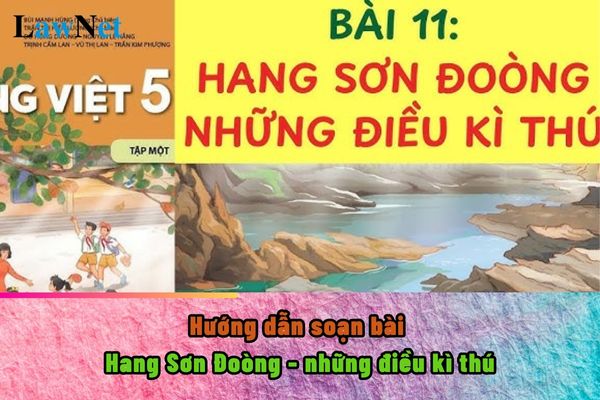What are guidelines on preparing the lesson "Hang Sơn Đoòng những điều kì thú" for grade 5 students in Vietnam?
What are guidelines on preparing the lesson "Hang Sơn Đoòng những điều kì thú" for grade 5 students in Vietnam?
"Hang Sơn Đoòng những điều kì thú" is one of the texts that students will learn in the grade 5 Literature program.
Grade 5 students may refer to the following guidelines on preparing the lesson "Hang Sơn Đoòng những điều kì thú".
|
Guidelines on preparing the lesson "Hang Sơn Đoòng những điều kì thú" for grade 5 students The text focuses on introducing Sơn Đoòng cave, a unique and the world's largest natural wonder. The main objectives of the text are: |
*Note: The information is for reference only./.

What are guidelines on preparing the lesson "Hang Sơn Đoòng những điều kì thú" for grade 5 students in Vietnam? (Image from the Internet)
What are the general qualities that students in Vietnam are required to achieve according to grade 5 Vietnamese Language?
Based on Section 3 of the Literature Education Program issued under Circular 32/2018/TT-BGDDT, the general objectives of the Literature Education Program are as follows:
- To form and develop in students essential qualities: patriotism, compassion, diligence, honesty, and responsibility; to nurture the soul, shape personality, and develop character.
To help students explore themselves and the world around them, to understand humans, to have a rich spiritual life, to possess a humanistic view of life and behavior; to have a love for Vietnamese language and literature; to have an awareness of national origins and identity, contributing to preserving and developing Vietnamese cultural values; to have a spirit of integrating global cultural essence and an international integration ability.
- To contribute to students developing general competencies: self-reliance and self-learning, communication and cooperation, problem-solving, and creativity.
Especially, the Vietnamese Literature (Vietnamese Language) subject helps students develop linguistic and literary competencies: practice reading, writing, speaking, and listening skills; possess a system of foundational general knowledge about Vietnamese language and literature, develop figurative and logical thinking, contributing to forming the fundamental education of a cultured person.
To know how to create common types of texts; to be able to receive, evaluate specific literary texts, communication products, and general aesthetic values in life.
Thus, teaching Grade 5 Literature requires students to possess common qualities such as patriotism, compassion, diligence, honesty, and responsibility; to nurture the soul, shape personality, and develop character.
How is the teaching duration for grade 5 Vietnamese Language allocated?
Based on Section 8 of the Literature Education Program issued under Circular 32/2018/TT-BGDDT, the duration for implementing the Literature subject program across educational levels is as follows:
[1] Program duration across grades (by number of class hours)
| Grade 1 | Grade 2 | Grade 3 | Grade 4 | Grade 5 | Grade 6 | Grade 7 | Grade 8 | Grade 9 | Grade 10 | Grade 11 | Grade 12 |
| 420 | 350 | 245 | 245 | 245 | 140 | 140 | 140 | 140 | 105 | 105 | 105 |
In upper secondary school, each grade has an additional 35 hours for optional study modules.
[2] Duration allocated for educational content
The duration for educational content is organized by textbook authors and teachers based on the requirements that need to be achieved in each grade and the actual teaching situation. However, the arrangements should ensure a reasonable balance among the following components:
- Between equipping knowledge and practicing skills (focusing on practicing practical skills, application).
- Among the types, and categories of texts for reading, writing, speaking, and listening (allotting more time for reading literary texts).
- Among reading, writing, speaking, and listening skills (allocating more time for developing reading skills); the specific proportion of time allocated for skills in each grade is as follows:
| Grade Group | Reading | Writing | Speaking and Listening | Periodic Assessment |
| From Grade 1 to Grade 3 | about 60% | about 25% | about 10% | about 5% |
| From Grade 4 to Grade 5 | about 63% | about 22% | about 10% | about 5% |
| From Grade 6 to Grade 9 | about 63% | about 22% | about 10% | about 5% |
| From Grade 10 to Grade 12 | about 60% | about 25% | about 10% | about 5% |
Additionally, time allocation for study modules in each grade is as follows:
| Study Module | Grade 10 | Grade 11 | Grade 12 |
| Module 10.1: Research and report on a folk literature issue | 10 | ||
| Module 10.2. Theater adaptation of literary works | 15 | ||
| Module 10.3. Reading, writing, and introducing a poetry collection, a short story collection, or a novel | 10 | ||
| Module 11.1: Research and report on a medieval literature issue | 10 | ||
| Module 11.2: Understanding language in modern society | 15 | ||
| Module 11.3: Reading, writing, and introduction about a literary author | 10 | ||
| Module 12.1. Research and report on a modern and postmodern literature issue | 10 | ||
| Module 12.2. Understanding an art piece adapted from literature | 15 | ||
| Module 12.3. Exploring the creative style of a literary school: Classical, realistic, or romantic. | 10 |
>>> Download the Literature Education Program issued under Circular 32/2018/TT-BGDDT
Thus, according to grade 5 Vietnamese Language curriculum, the time distribution is approximately 63% for reading, 22% for writing, 10% for listening, and 5% for periodic assessment.

